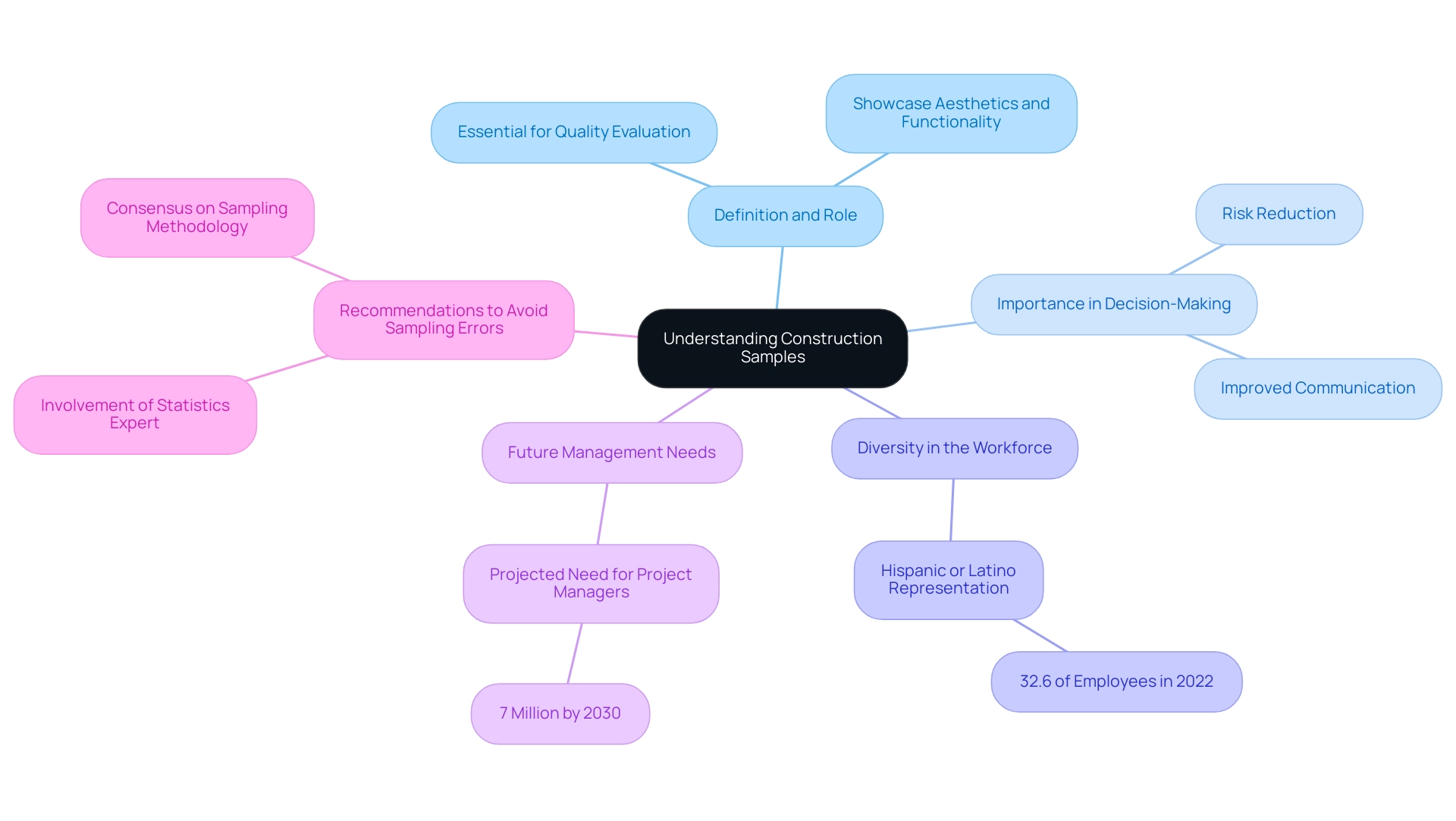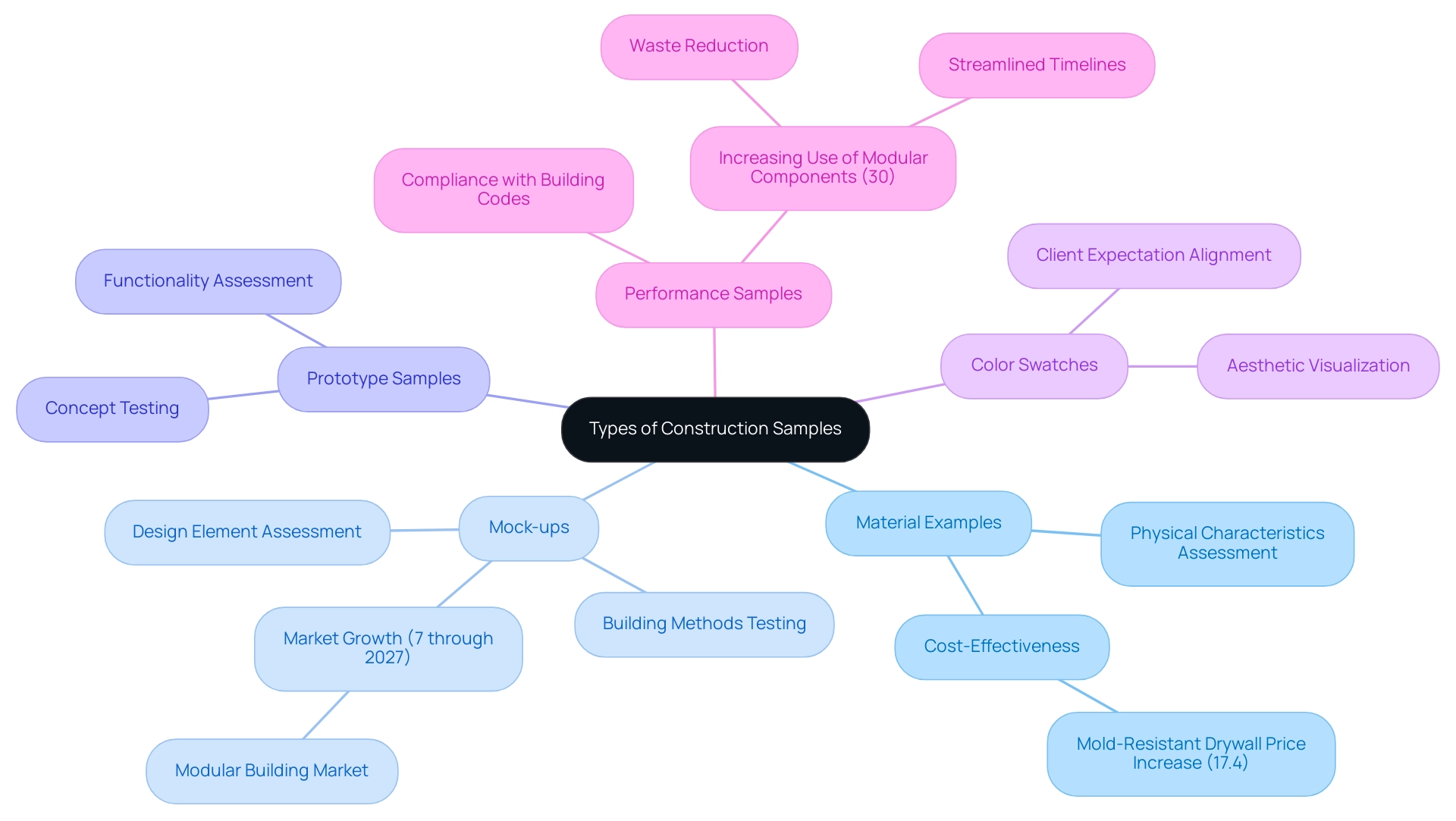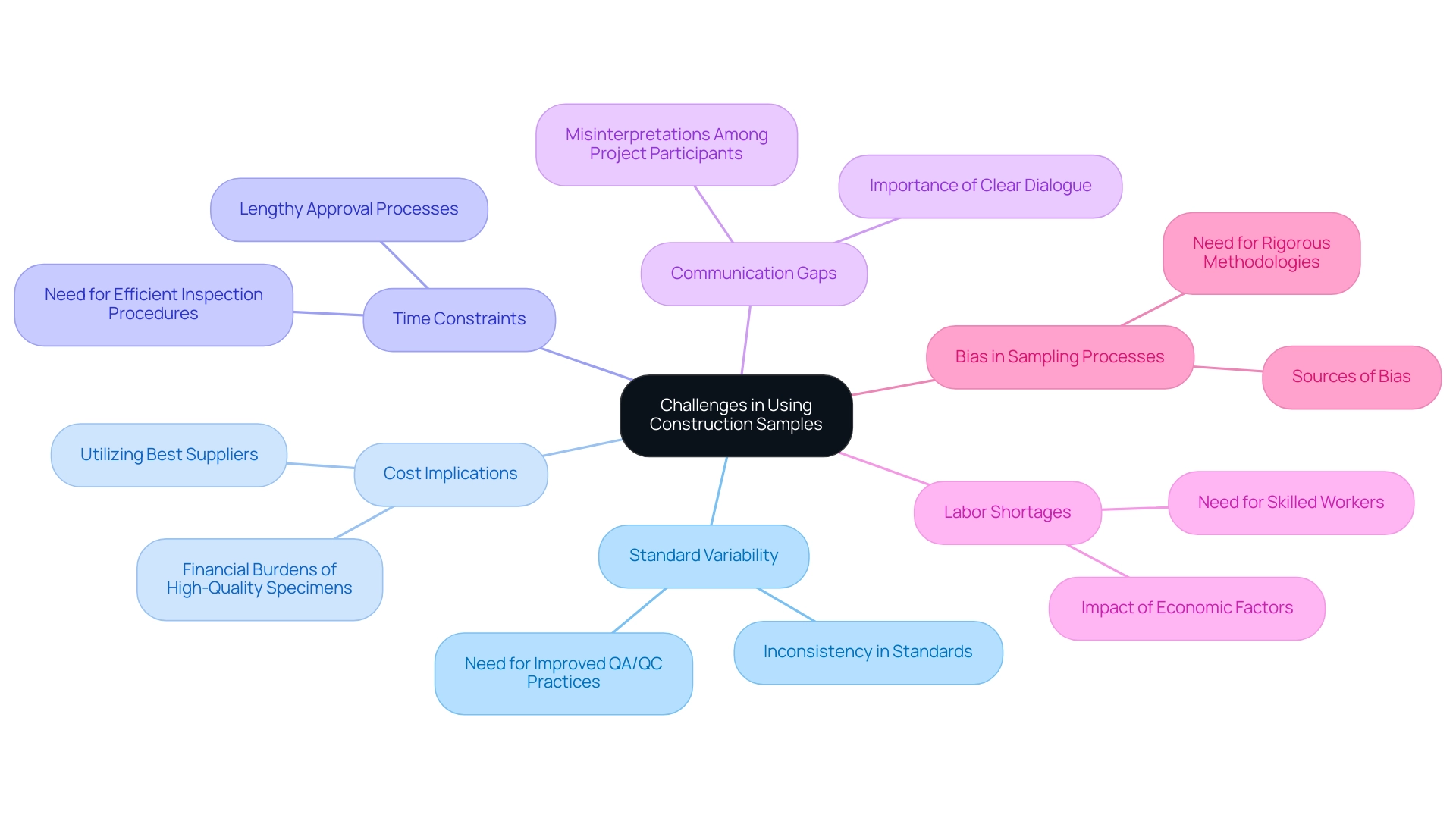What Are Construction Samples? A Comprehensive Overview
Discover the role and importance of samples construction in ensuring quality and project success.

Overview:
Construction samples are defined as representative examples of materials, products, or assemblies that are crucial for evaluating quality, aesthetics, and functionality before full-scale implementation in projects. The article highlights their importance through detailed discussions on various types of samples, the selection and approval process guided by Acceptable Quality Level standards, and emerging trends such as digitalization and sustainability, which collectively enhance decision-making and project outcomes in the construction industry.
Key Highlights:
- Construction samples are essential for evaluating materials' quality, aesthetics, and functionality before full-scale implementation.
- Diverse types of construction samples include material examples, mock-ups, prototypes, color swatches, and performance samples, each serving specific evaluation purposes.
- The selection and approval process for construction samples involves identifying materials, assessing samples, reaching consensus, and documenting approvals, guided by Acceptable Quality Level (AQL) standards.
- Challenges in using construction samples include standard variability, cost implications, time constraints, communication gaps, labor shortages, and bias in sampling processes.
- The future of construction samples is shaped by trends in digitalization, sustainability, customization, and enhanced collaboration tools, improving decision-making and project outcomes.
- Recent statistics indicate a need for diverse perspectives in the building sector, and the demand for skilled project managers is expected to rise significantly by 2030.
Introduction
In the ever-evolving landscape of the construction industry, the significance of construction samples cannot be overstated. These samples serve as critical touchpoints that inform decision-making, mitigate risks, and enhance collaboration among architects, designers, and contractors. By providing tangible representations of materials, products, and assemblies, construction samples ensure that projects not only meet aesthetic and functional standards but also adhere to regulatory requirements.
As the industry grapples with challenges such as quality variability, cost implications, and labor shortages, the strategic use of construction samples emerges as a vital component in maintaining project integrity and achieving successful outcomes.
This article delves into the multifaceted role of construction samples, examining their:
- Types
- Selection processes
- Inherent challenges
- Transformative trends shaping their future in the construction sector.
Understanding Construction Samples: Definition and Importance
Test specimens play an essential role in samples construction, encompassing representative examples of materials, products, or assemblies that showcase quality, aesthetics, and functionality prior to full-scale implementation. These samples construction are indispensable for architects, designers, and contractors, as they enable thorough evaluation of the physical attributes of materials, aiding in informed decision-making. The importance of samples construction is profound; it not only assists in reducing risks by ensuring that chosen materials conform to specifications and standards, but also improves communication among all stakeholders.
This shared understanding is crucial for achieving objectives and expectations. Recent data from the building sector illustrates that 32.6% of employees identified their ethnicity as Hispanic or Latino in 2022, which underscores the importance of incorporating diverse perspectives in the sampling process to enrich decision-making. Furthermore, the Project Management Institute underscores the expected need for approximately 7 million managers by 2030, stressing that the emphasis on quality evaluation through samples construction will grow more essential in addressing industry requirements.
To further illustrate this point, the case study 'Potential Issues and Solutions in Sampling' reveals that avoiding sampling errors and bias is essential for claim success, recommending the involvement of a statistics expert and consensus on samples construction among stakeholders. These developments highlight the need for effective methodologies in samples construction that prevent sampling errors, which could otherwise jeopardize success.

Types of Construction Samples and Their Applications
In the building sector, samples construction of a diverse array of types plays a critical role in ensuring that projects meet aesthetic, functional, and regulatory standards. OpsNinja's dedicated quality customer service team is available to support stakeholders throughout this process, offering personalized assistance in inspection planning and real-time monitoring. The following outlines key categories of construction samples:
-
Material Examples: These examples, which can include tiles, bricks, or paint, are essential for assessing a material's physical characteristics such as color, texture, and durability. Their selection is critical in the decision-making process, especially given that mold-resistant drywall prices have recently increased by 17.4%. This price rise highlights the significance of thoroughly assessing samples construction to guarantee cost-effectiveness and quality in planning.
-
Mock-ups: Full-scale models of specific sections, mock-ups are invaluable for assessing design elements, building methods, and material finishes. They are especially effective in complex projects where both aesthetics and functionality require real-world testing, reflecting the market's commitment to innovation. Notably, the modular building market is projected to experience robust growth, with an anticipated annual increase of nearly 7% through 2027, as indicated by Grand View Research. This trend emphasizes the importance of modular components in the context of construction examples.
-
Prototype Samples: Acting as preliminary versions of products or systems, prototypes allow designers and engineers to test concepts and functionalities. For example, a prototype window system can reveal potential energy efficiency issues or weather resistance concerns before mass production begins, ensuring better performance outcomes.
-
Color Swatches: Widely used in interior design, color swatches assist clients in visualizing the overall aesthetic of a space. These can vary from paint swatches to fabric pieces, crucial for aligning client expectations with design vision.
-
Performance Samples: Tested against specific criteria such as insulation properties or fire resistance, performance samples are vital for compliance with building codes and regulations. Their significance is emphasized by the recent trend of increasing the use of modular and prefabricated components by 30%, which streamlines timelines and reduces waste.
Additionally, referencing the case study titled 'Statistics of Income' related to federal taxation provides a broader understanding of economic factors impacting the building sector. By integrating these different kinds of samples construction into the process, stakeholders can guarantee that the final product not only aligns with their vision but also satisfies rigorous standards and client expectations. OpsNinja's integrated platform further enhances this process, providing tools that streamline the sampling and inspection workflow, ultimately reflecting an industry increasingly committed to sustainability through technology and innovative design.

The Process of Selecting and Approving Construction Samples
The selection and approval of construction samples is a critical process that ensures the integrity and quality of materials used in endeavors, particularly regarding AQL numbers that establish acceptable quality standards. AQL (Acceptable Quality Level) numbers guide the sampling process by determining how many products should be inspected and what constitutes an acceptable number of defects. This process typically unfolds through several essential steps:
- Initial Identification: Key stakeholders, including architects and contractors, begin by identifying the necessary materials and products. This identification is guided by stringent design specifications and functional requirements that reflect the objectives of the endeavor. Stakeholders then request samples construction from manufacturers or suppliers, specifying the exact materials needed for evaluation.
This step is crucial for ensuring that the specimens align with project expectations, mitigating the risk of negative customer experiences.
- Assessment: Upon receiving the samples construction, a comprehensive evaluation is conducted. This assessment encompasses the physical attributes, performance characteristics, and compliance with relevant standards as they relate to samples construction, including AQL metrics.
For instance, if the AQL is set at 2%, this means that out of a sample of 100 units, a maximum of 2 defects is acceptable. As noted in recent judicial commentary, the complexity and data-heavy nature of construction projects are increasingly leading to the adoption of statistical sampling methods to resolve disputes effectively. This trend emphasizes the need for D2C brands to implement rigorous quality control measures to prevent product returns.
-
Approval Process: Following the evaluation, stakeholders engage in discussions to reach a consensus on which samples construction meets the established criteria. This process not only involves comparing various options but also reflects a growing trend towards data-driven decision-making in building practices. Recent court approvals indicate a trend towards increased use of sampling, illustrating the potential for a 'statistical revolution' in legal practices related to building disputes.
-
Documentation: Once samples are approved, meticulous documentation is essential, including securing necessary approvals from regulatory bodies to ensure compliance with industry standards. Such documentation acts as an essential reference during the building process, assisting in standard control and strengthening brand protection strategies. By following this organized method and incorporating AQL standards, samples construction teams can significantly improve management processes, reduce risks, and ensure that materials align with the overarching goals of the project.
This diligence is essential not only for maintaining product standards but also for safeguarding brands from negative reviews and ensuring customer satisfaction. Furthermore, utilizing platforms such as OpsNinja can further help D2C brands in optimizing their assurance processes, ultimately contributing to a positive customer experience.

Challenges in Using Construction Samples
The application of building examples is crucial for guaranteeing standards in initiatives; however, various obstacles can impede their efficiency:
- Standard Variability: A major problem arises from the inconsistency in standard noted between samples construction and the actual materials provided to building sites. This inconsistency often stems from fluctuations in manufacturing processes or alterations in material sourcing, which can affect the samples construction and lead to potential discrepancies in project integrity.
Expert Chin Hon Sin emphasizes that, > The QA/QC practices in the construction industry for material are in dire need of revamping and improvement <, highlighting the urgent need for better standards in material excellence. OpsNinja’s comprehensive inspection services can address these concerns by performing thorough inspections and providing detailed reports, ensuring that the materials meet standards before they reach the site. Furthermore, customer Ernest Ofori noted the exceptional communication and thoroughness of the testing process, praising the impressive use of pictures and videos during inspections, which underscores the importance of reliable sampling practices.
-
Cost Implications: Acquiring high-quality specimens can impose substantial financial burdens, especially for extensive projects that necessitate a wide variety of materials. Budget limitations may restrict the capacity to invest in high-end materials, ultimately affecting the overall standard of samples construction. OpsNinja helps mitigate these costs by ensuring that only the best suppliers are utilized, reducing the likelihood of costly returns due to quality issues.
-
Time Constraints: The process of selecting and approving samples construction can often be lengthy, posing a risk of delays if not managed judiciously. Tight timelines may compel teams to expedite decision-making, which can lead to less-than-ideal choices that compromise results. OpsNinja’s efficient inspection procedure is intended to accelerate control of standards, enabling tasks to remain on schedule.
-
Communication Gaps: Effective communication among all project participants is essential for aligning expectations regarding the characteristics of the samples construction process. Misinterpretations can result in dissatisfaction with the final outcomes, underscoring the need for clear dialogue throughout the process. OpsNinja excels in this area, as highlighted by Ofori's praise for their communication during the inspection process.
-
Labor Shortages: The construction industry is currently grappling with a persistent labor shortage, exacerbated by the aftermath of the 2008 Great Recession and the COVID-19 pandemic. This shortage complicates the samples construction of excellent specimens, as fewer skilled workers are available to ensure that proper collection and assurance practices are followed. OpsNinja’s expertise in managing inspections helps alleviate some of these burdens by providing professional oversight.
-
Bias in Sampling Processes: A case study highlights various sources of bias that can affect sampling results, including non-random selection methods and measurement errors. Bias is a significant factor in the failure of sampling claims, which underscores the need for rigorous samples construction methodologies to ensure valid and reliable results. OpsNinja's structured approach to inspections helps mitigate these biases, ensuring that sampling processes are as unbiased and accurate as possible.
To mitigate these challenges, stakeholders should emphasize transparent communication, establish realistic timelines, and conduct comprehensive evaluations to ensure that the selected samples meet the project's specific requirements.
By utilizing OpsNinja's dependable inspection services, especially considering the ongoing labor shortages and variability concerns affecting the industry, D2C brand owners can safeguard their brand reputation against negative feedback and significantly decrease returns. The case study of Hash Stash illustrates this, showing how OpsNinja's inspections have led to a 30% reduction in product returns, further solidifying their role in enhancing quality control.

The Future of Construction Samples in the Industry
The future of building prototypes is on the verge of notable change as the sector increasingly adopts innovation and sustainability. Key trends shaping this evolution include:
- Digitalization: The implementation of digital tools and platforms is revolutionizing the samples construction and approval processes for selecting sample materials.
Technologies such as virtual reality (VR) and augmented reality (AR) empower stakeholders to visualize materials within their intended context, enhancing the decision-making process. Deloitte emphasizes that AI and advanced data analytics could yield cost savings of 10% to 15% on building projects, further underscoring the financial benefits of digitalization. Staying ahead of technology trends is crucial for maintaining a competitive advantage in the building sector, as companies that leverage these innovations can improve efficiency and reduce costs.
- Sustainability Focus: With a growing commitment to sustainable practices, the demand for eco-friendly building materials is surging. As the industry pivots towards greener solutions, the samples construction will increasingly reflect this shift, showcasing materials that adhere to environmental standards and contribute to green building certifications. Recent government investments, especially since the Infrastructure Investment and Jobs Act (IIJA) was enacted in 2021, have significantly boosted spending in manufacturing development, promoting the use of sustainable materials in nonresidential infrastructure projects.
This investment not only promotes sustainability but also reduces the risks linked to disputes in the building sector, which average $54.26 million globally, highlighting the financial consequences of poor decision-making.
-
Customization: Innovations in manufacturing technology are enabling a higher degree of customization in construction prototypes. This trend enables architects and designers to request examples customized to their specific needs, fostering greater creativity and innovation in design.
-
Collaboration and Communication Tools: Enhanced collaboration tools are streamlining communication among stakeholders, facilitating real-time feedback and adjustments throughout the selection process. This enhanced connectivity ensures that all participants are aligned with project goals, ultimately driving successful outcomes.
By proactively engaging with these trends, stakeholders can harness samples construction as strategic instruments for ensuring quality and alignment with project objectives, setting the stage for future success in an evolving market.

Conclusion
The exploration of construction samples reveals their essential role in the construction industry, serving as invaluable tools for informed decision-making, risk mitigation, and enhanced collaboration among stakeholders. By understanding the various types of samples—material, mock-ups, prototypes, color, and performance—professionals can ensure that projects not only meet aesthetic and functional requirements but also adhere to stringent regulatory standards. The structured selection and approval process, guided by Acceptable Quality Level (AQL) metrics, further underscores the importance of maintaining quality and consistency throughout the construction lifecycle.
Despite their significance, challenges such as quality variability, cost implications, time constraints, and labor shortages can impede the effectiveness of construction samples. Addressing these issues through transparent communication, rigorous evaluation, and leveraging technological innovations is crucial for optimizing the sampling process. As the industry evolves, embracing trends such as digitalization, sustainability, customization, and improved collaboration will enhance the strategic use of construction samples, ultimately leading to better project outcomes.
In summary, the future of construction samples is bright, with opportunities for innovation and improvement that can significantly impact project integrity and success. By prioritizing quality assessment and embracing emerging technologies, stakeholders can navigate the complexities of the construction landscape, ensuring that their projects not only meet but exceed expectations. The proactive engagement with these trends will position construction professionals to drive forward an industry increasingly committed to excellence and sustainability.



